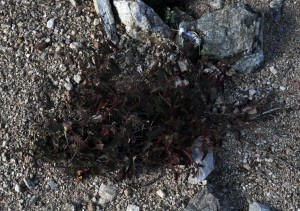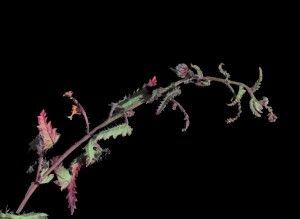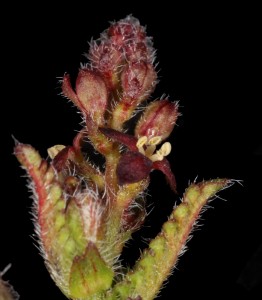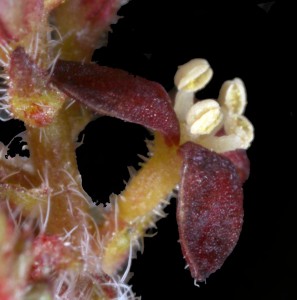The forecast yesterday included high winds and a chance of rain. Ed and I set off for Saguaro National Park East and the Cactus Forest Trail. We walked past the old lime kilns, came to a junction in the trail and decided to head for Lime Falls. The trail in part follows a stream bed. There were even a few little pools of water left over from rain last week. As we walked I told Ed about my new interest in Spurges – members of the Euphorbia family. It is a very large family with 300 genera and about 7,500 species. Many of them have “invisible” flowers as I have noted in this blog before. Probably the most famous, especially this time of year, is Poinsettia (Euphorbia pulcherrima). Poinsettia flowers are very small, hidden in the center of the top leaves. The leaves are the showy part and may be red or a variety of other colors.
I told Ed that I had even thought of buying a book about this family, but learned that the one that seemed the most interesting costs about $500 (in a ten-volume set). It is definitely a fascinating family, but maybe not worth that much to me right now. Just then I looked down in the stream bed and saw a rather dark plant. Some of its leave had turned red. I knew at once it was Nose burn (Tragia nepetifolia), so called because its leaves irritate the skin. Until today I had never dared to pick the plant or inspect the flowers at close range. It seemed to both of us that it was not in bloom. A few days ago I had looked for flowers on this plant in Molino Basin and concluded that it was long past blooming, so I assumed that this one was no longer in flower. But then, realizing that we were dealing with an “invisible” flower, I leaned down, and inspected it with my loupe. To my delight it was in full and glorious bloom. I picked a sprig, not worrying at all about its stinging reputation. It was not very irritating after all. Here are the pictures I took of this fascinating plant.
Looking straight down at Nose burn in the stream bed. One would not expect to find flowers on this plant, which was about a foot wide.
This branch is a little the worse for wear. Note how some leaves have turned red. The flowering part is at the top of the branch.
This is a close-up of the flowering head.
And a close-up of the close-up.
We met a couple on the trail, and after a brief conversation realized that we had met them before much higher up on the mountain – an area called Bear Wallow. They were Rick and Pat, and were very much interested in all aspects of nature, so we introduced them to this “invisible” flower and invited them to join the blog so that they could see these pictures.
It was a very pleasant day in the desert. We even saw other plants in bloom, including a Brittle bush, Wire lettuce, Dalea (pulchra, we think), and now this Nose burn.
When I woke up this morning there were three tenths of an inch in the rain gauge, so the rain did come, and very welcome it is.





Thank you, Frank. Posts like this may fully convince me to slow down to a crawl so as not to miss these delights.
Amazing close ups!